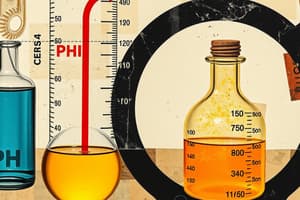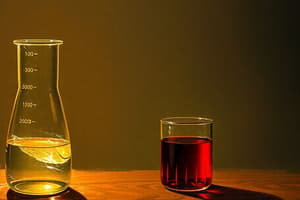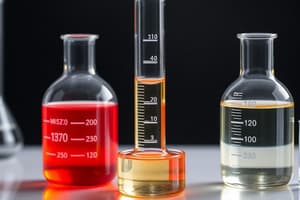Podcast
Questions and Answers
What is the purpose of a titration in volumetric analysis?
What is the purpose of a titration in volumetric analysis?
A titration is used to determine the concentration of a solution by adding a measured volume of another solution until the reaction is complete.
What is one key feature of a volumetric flask?
What is one key feature of a volumetric flask?
A volumetric flask is designed to contain a definite volume of solution and has an engraved graduation mark on its neck.
Why should a graduated cylinder be rinsed with deionised water before use?
Why should a graduated cylinder be rinsed with deionised water before use?
Rinsing a graduated cylinder with deionised water removes contaminants and ensures accurate measurement of liquids.
How does one correctly fill a pipette before use?
How does one correctly fill a pipette before use?
What steps should be taken to ensure a homogenous mixture in a volumetric flask after preparing a solution?
What steps should be taken to ensure a homogenous mixture in a volumetric flask after preparing a solution?
What is the mass of NaCl in grams in a 0.25 M NaCl solution?
What is the mass of NaCl in grams in a 0.25 M NaCl solution?
What is the molarity of a solution containing 3.68 g of NaOH per litre?
What is the molarity of a solution containing 3.68 g of NaOH per litre?
How many moles of NaOH are in 25 cm³ of a 0.55 M NaOH solution?
How many moles of NaOH are in 25 cm³ of a 0.55 M NaOH solution?
What mass of Magnesium reacts with 50 cm³ of 0.5 M H₂SO₄?
What mass of Magnesium reacts with 50 cm³ of 0.5 M H₂SO₄?
How do you calculate the number of moles of solute in a diluted solution?
How do you calculate the number of moles of solute in a diluted solution?
What volume of 12 M HCl is required to prepare 500 cm³ of a 3 M HCl solution?
What volume of 12 M HCl is required to prepare 500 cm³ of a 3 M HCl solution?
What is the molecular mass of NaOH?
What is the molecular mass of NaOH?
What is the relation between moles of H₂SO₄ and Mg in the reaction Mg + H₂SO₄?
What is the relation between moles of H₂SO₄ and Mg in the reaction Mg + H₂SO₄?
What is the purpose of rinsing a pipette with deionised water before use?
What is the purpose of rinsing a pipette with deionised water before use?
Why is it important to touch the tip of the pipette against the side of the glass beaker after filling?
Why is it important to touch the tip of the pipette against the side of the glass beaker after filling?
What is the significance of the meniscus when measuring liquids in a pipette?
What is the significance of the meniscus when measuring liquids in a pipette?
Describe the proper procedure for filling a burette with hydrochloric acid solution.
Describe the proper procedure for filling a burette with hydrochloric acid solution.
What should be done if air bubbles are found in the nozzle of the burette?
What should be done if air bubbles are found in the nozzle of the burette?
Why should a conical flask not be rinsed with the solution it is to contain?
Why should a conical flask not be rinsed with the solution it is to contain?
What is the purpose of adding methyl orange indicator to the sodium carbonate solution?
What is the purpose of adding methyl orange indicator to the sodium carbonate solution?
What is the role of the conical flask when transferring the sodium carbonate solution?
What is the role of the conical flask when transferring the sodium carbonate solution?
What is the definition of a solution?
What is the definition of a solution?
How is weight per weight (w/w) concentration expressed?
How is weight per weight (w/w) concentration expressed?
What is the purpose of diluting the vinegar solution before titration?
What is the purpose of diluting the vinegar solution before titration?
What does a 0.85% w/v solution of NaCl indicate regarding mass?
What does a 0.85% w/v solution of NaCl indicate regarding mass?
What change occurs to the phenolphthalein indicator at the endpoint of the titration?
What change occurs to the phenolphthalein indicator at the endpoint of the titration?
What is the significance of parts per million (ppm) in solution concentration?
What is the significance of parts per million (ppm) in solution concentration?
Define molarity and its significance in solution concentration.
Define molarity and its significance in solution concentration.
Why is it important to rinse the burette and pipette with the solutions intended for use before starting the titration?
Why is it important to rinse the burette and pipette with the solutions intended for use before starting the titration?
How do you calculate the concentration of ethanoic acid in the diluted vinegar solution?
How do you calculate the concentration of ethanoic acid in the diluted vinegar solution?
How do you convert a 0.25 M NaCl solution to grams per litre?
How do you convert a 0.25 M NaCl solution to grams per litre?
What is the final step you must take after preparing the sodium carbonate solution in a volumetric flask?
What is the final step you must take after preparing the sodium carbonate solution in a volumetric flask?
What does a 10% v/v ethanol solution mean?
What does a 10% v/v ethanol solution mean?
What is the formula for calculating the mass of solute needed for a specific volume in w/v?
What is the formula for calculating the mass of solute needed for a specific volume in w/v?
What does the term 'water of crystallisation' refer to in the context of hydrated sodium carbonate?
What does the term 'water of crystallisation' refer to in the context of hydrated sodium carbonate?
What is the significance of obtaining consistent titration readings within 0.1 cm^3?
What is the significance of obtaining consistent titration readings within 0.1 cm^3?
What observation indicates the endpoint in the titration using methyl orange?
What observation indicates the endpoint in the titration using methyl orange?
What does the term 'standardised solution' mean in the context of titrations?
What does the term 'standardised solution' mean in the context of titrations?
Outline the steps to prepare a 250 cm^3 solution from a weighed sample of washing soda crystals.
Outline the steps to prepare a 250 cm^3 solution from a weighed sample of washing soda crystals.
What precaution should be taken as the end point of the titration approaches, and why is it important?
What precaution should be taken as the end point of the titration approaches, and why is it important?
Identify a suitable indicator for the titration of sodium carbonate with hydrochloric acid and describe the colour change observed.
Identify a suitable indicator for the titration of sodium carbonate with hydrochloric acid and describe the colour change observed.
Calculate the concentration of sodium carbonate (Na2CO3) in the original solution in moles per litre based on the titration results.
Calculate the concentration of sodium carbonate (Na2CO3) in the original solution in moles per litre based on the titration results.
Using the concentration calculated, what is the concentration of sodium carbonate in grams per litre?
Using the concentration calculated, what is the concentration of sodium carbonate in grams per litre?
Describe how to calculate the percentage water of crystallisation and the value of x in the formula Na2CO3.xH2O.
Describe how to calculate the percentage water of crystallisation and the value of x in the formula Na2CO3.xH2O.
Why is it essential to dissolve the samples thoroughly before titration?
Why is it essential to dissolve the samples thoroughly before titration?
Flashcards
Concentration of a solution
Concentration of a solution
The amount of solute dissolved in a given volume of solution.
Weight per weight (w/w)
Weight per weight (w/w)
Grams of solute per 100 grams of solution.
Weight per volume (w/v)
Weight per volume (w/v)
Grams of solute per 100 cm³ of solution.
Parts per million (ppm)
Parts per million (ppm)
Signup and view all the flashcards
Molarity
Molarity
Signup and view all the flashcards
1 Molar (1M) solution
1 Molar (1M) solution
Signup and view all the flashcards
0.85% w/v NaCl solution
0.85% w/v NaCl solution
Signup and view all the flashcards
Calculating NaCl mass in a solution
Calculating NaCl mass in a solution
Signup and view all the flashcards
What is titration?
What is titration?
Signup and view all the flashcards
What's a volumetric flask used for?
What's a volumetric flask used for?
Signup and view all the flashcards
Why rinse a volumetric flask with deionized water?
Why rinse a volumetric flask with deionized water?
Signup and view all the flashcards
Pipette purpose?
Pipette purpose?
Signup and view all the flashcards
How to make a homogenous solution?
How to make a homogenous solution?
Signup and view all the flashcards
Pipette Filler
Pipette Filler
Signup and view all the flashcards
Meniscus
Meniscus
Signup and view all the flashcards
Conical Flask
Conical Flask
Signup and view all the flashcards
Standard Solution
Standard Solution
Signup and view all the flashcards
Titration
Titration
Signup and view all the flashcards
Burette
Burette
Signup and view all the flashcards
Methyl Orange Indicator
Methyl Orange Indicator
Signup and view all the flashcards
Why rinse a pipette?
Why rinse a pipette?
Signup and view all the flashcards
Standardized solution
Standardized solution
Signup and view all the flashcards
Dissolving a sample in a volumetric flask
Dissolving a sample in a volumetric flask
Signup and view all the flashcards
Precaution for accurate titration
Precaution for accurate titration
Signup and view all the flashcards
Suitable indicator for titration
Suitable indicator for titration
Signup and view all the flashcards
Calculating sodium carbonate concentration
Calculating sodium carbonate concentration
Signup and view all the flashcards
Percentage water of crystallization
Percentage water of crystallization
Signup and view all the flashcards
Value of 'x' in hydrated salt formula
Value of 'x' in hydrated salt formula
Signup and view all the flashcards
What is the formula to calculate molarity?
What is the formula to calculate molarity?
Signup and view all the flashcards
How do you convert grams/liter to molarity?
How do you convert grams/liter to molarity?
Signup and view all the flashcards
Calculate moles of solute from volume and molarity
Calculate moles of solute from volume and molarity
Signup and view all the flashcards
How do you dilute a solution?
How do you dilute a solution?
Signup and view all the flashcards
Dilution equation
Dilution equation
Signup and view all the flashcards
What is the stoichiometry of a reaction?
What is the stoichiometry of a reaction?
Signup and view all the flashcards
How to calculate the mass of a reactant that reacts with a given volume of solution?
How to calculate the mass of a reactant that reacts with a given volume of solution?
Signup and view all the flashcards
Why is a volumetric flask used?
Why is a volumetric flask used?
Signup and view all the flashcards
What is a burette used for?
What is a burette used for?
Signup and view all the flashcards
How do you ensure a homogenous solution?
How do you ensure a homogenous solution?
Signup and view all the flashcards
What's the purpose of rinsing the burette?
What's the purpose of rinsing the burette?
Signup and view all the flashcards
What's the indicator used in the vinegar titration?
What's the indicator used in the vinegar titration?
Signup and view all the flashcards
What's the formula for hydrated sodium carbonate?
What's the formula for hydrated sodium carbonate?
Signup and view all the flashcards
What's the indicator used in the sodium carbonate titration?
What's the indicator used in the sodium carbonate titration?
Signup and view all the flashcards
What's the purpose of the titration?
What's the purpose of the titration?
Signup and view all the flashcards
Study Notes
Volumetric Analysis: Acid-Base
- Solution: A perfect mixture of solute and solvent where solute particles are distributed uniformly throughout the solvent (homogeneous).
- Solution Concentration: The amount of solute dissolved in a given volume of solution. Several ways to express this include percentage (w/w, w/v, v/v), parts per million (ppm) and molarity.
- Weight per weight (w/w): Grams of solute per 100 grams of solution.
- Weight per volume (w/v): Grams of solute per 100 cm³ of solution.
- Volume per volume (v/v): Volume of solute per 100 cm³ of solution.
- Parts per million (ppm): A unit for very dilute solutions, used in water analysis. (1 mg per litre = 1 ppm)
- Molarity: Moles of solute per litre of solution (1M = 1 mole/litre).
- Conversions: Converting between different concentration units is possible.
Expressing Concentrations of Solutions
- Example (w/v): A 0.85% w/v salt solution means 0.85 grams of salt per 100 cm³ of solution.
- Example (0.85 w/v and 250 cm³): To make 250 cm³ of a 0.85% w/v NaCl solution, 2.125 grams of NaCl are needed.
Moles of Solute Per Litre of Solution (Molarity)
- Example calculation: What is the molarity of a solution containing 3.68 g of NaOH per litre of solution? Rel. Molecular Mass of NaOH = 40. 3.68g/40g/mol = 0.092 M NaOH solution.
Converting Moles per Litre to Grams per Litre
- Example calculation: How many grams of NaCl per litre are present in a solution marked 0.25 M NaCl? Rel. Molecular Mass of NaCl = 58.5g/mol. 0.25 M x 58.5g/mol = 14.625 g/L
Converting Grams per Litre to Moles per Litre (Molarity)
- Example Calculation: What is the molarity of a solution containing 3.68 g of NaOH per litre of solution? Rel. Molecular Mass of NaOH = 40. 3.68 g / 40 g/mol = 0.092 M NaOH solution.
Dilution of Solutions
- Formula: (Volume of dilute solution x Molarity of dilute solution) / 1000 = (Volume of concentrated solution x Molarity of concentrated solution) / 1000
- Example calculation: What volume of 12 M HCl solution is needed to make 500 cm³ of 3 M HCl solution? (500 x 3) / 1000= ( X x 12) / 1000; X = 125 cm³.
Standard Solutions
- Definition: A solution whose concentration is accurately known.
- Primary Standard: A stable, pure, and readily soluble solid substance used to prepare a standard solution.
- Criteria for primary standards: Available in a pure state, stable in air, dissolve easily in water; high relative molecular mass; complete and rapid reaction; non-hydrated.
Volumetric Analysis: Titrations
- Definition: A procedure to determine the concentration of an unknown solution by reacting it with a solution of known concentration.
Apparatus
- Graduated Cylinder: Used for approximate volumes of liquids.
- Volumetric Flask: Designed to hold a specific volume of solution for accurately measuring solutions.
- Pipette: Used for the accurate delivery of a precise volume of liquid.
- Conical Flask: A flask with a wide mouth used in titration experiments.
Reaction between a Solution and a Solid
- Example calculation: Mg + H2SO4 → MgSO4 + H2. What mass of Magnesium will react with 50cm³ of 0.5 M H2SO4? 0.5 M x 50 cm³ / 1000 = 0.025 Moles. 0.025 moles x 24 g/mol = 0.6 g.
Titrations Methods and Calculations
- Trial titrations: Are performed before the actual titration to estimate/narrow in on the end point.
Studying That Suits You
Use AI to generate personalized quizzes and flashcards to suit your learning preferences.
Related Documents
Description
Explore the concepts of volumetric analysis focusing on acid-base solutions. This quiz covers the definitions, calculations, and methods for expressing solution concentrations including molarity and parts per million. Enhance your understanding of solutions in chemistry.




